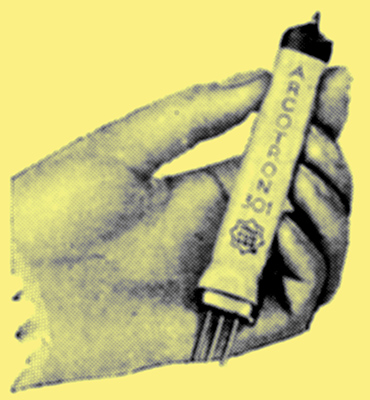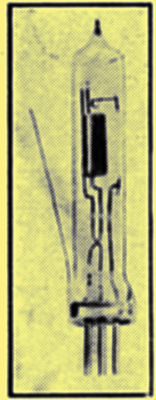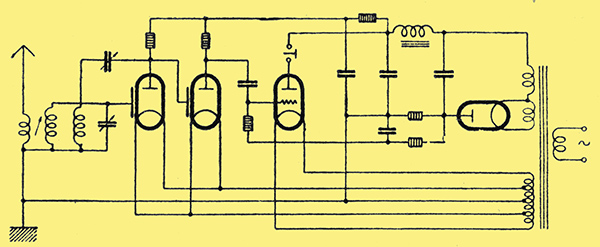|
Some authentic technical details about those amazing little mains valves with external control electrodes.

Attempts to control the electrons in a valve statically, from outside the glass, date back to the early days of valve development. However, the tests carried out failed to lead to any tangible results owing to the impossibility of obtaining sufficient amplification for practical purposes.
This was mainly due to the fact that in the case of ordinary bulbs the control electrode could not possibly influence the space charge around the cathode. The peculiar shape of radio rods had to be adopted in order that the controlling outside surface might encompass the area of the space charge sufficiently closely.

Inside view of one type of rod.
Bias Ineffective
Radio rods are subject to operating conditions altogether different from those of ordinary valves. It is, for instance, impossible to record any statical characteristics of this new type of valve, the glass wall being charged inside with electrons whenever a positive voltage is applied to the control grid, while the total voltage resulting from that of the control coating and the voltage of the charge on the inside of the wall is always nil. No amount of positive grid bias has any effect.

Another type of radio rod.
Use of Gas-filled Rods
This is true also more or less of any negative voltage applied to the control coating, providing there are some slight remnants of gas in the valve. At the same time, gas-filled Telefunken rods will respond to alternating HF voltages, there being set up excess charges on the wall whenever the voltage of the outside coating is varied, so that the resulting voltage no longer is nil. These excess charges always take a certain time to be compensated across the insulation resistance of the glass wall.
Telefunken rods destined for purposes of amplification are designed as high vacuum valves, whereas those devised for detecting purposes are of the gas-filled type.
Telefunken rods are directly heated with alternating current. No directly heated mains valves have so fax been very successful as detectors, owing to the direct effect exerted by the filament on the grid and the influence of voltage variations on rectification.
However, gas-filled Telefunken rods, on account of their characteristic behaviour, as explained, are insensitive low-frequency voltages.

Outside view of one of the rods.
Detecting Action
Any voltages applied from outside are, so far as the negative half wave is concerned, compensated by the ions of the residual gas; in fact, the lag between the electrons and ions is only felt as the frequency becomes more rapid, until the ions in the case of real high frequency are no longer able to follow.
Only low frequency oscillations are thus compensated by ions, resulting in a rectifying effect which is quite similar to the detecting effect of standard valves.
The insensitiveness of the gas-filled radio rod to low frequency by no means affects the low frequency modulations of the HF pulses. Oscillation on the grid being invariably of high frequency, and being in turn modulated in accordance with the rhythm of the speech or music transmitted.
Insensitive to LF Pulses
Whereas a frequency of, say, 100 reaching the grid from the alternating-current mains has practically no influence upon detector rods, a sound of the frequency of 100 arriving from the transmitter in the form of modulated high frequency will readily be passed on.
Smoothing Apparatus Simplified
The most conspicuous advantage of gas-filled Telefunken rods, therefore, is seen to be in the absence of any grid hum, thus greatly simplifying the design of the smoothing apparatus.
Another most welcome advantage of radio rods is that, owing to direct heating, they will start working immediately they are switched on.

The circuit connections of an all-mains radio-rod receiver.
A diagram is shown of a typical circuit for these rods. Coupling condensers and grid resistances between the detecting and resistance rods respectively can be dispensed with, the steady voltage of the control coating being without any influence on the working of the valve.
Telefunken rods behave in many respects in different ways from standard valves, and enable considerable simplification of the circuits it employed. Instances of this have already been given, namely, the absence of coupling condensers, and the fact that directly-heated cathodes can be utilised. The property of the detector of being unresponsive to low frequency pulses has the advantage of making the question of back coupling from following LF stages of much less importance.
Ordinary Output Valve
You have seen why radio rods are not suitable for LF purposes, and therefore will not be surprised to note that a three electrode valve of the ordinary type is utilised for the output. The circuit shown is, of course, a three-valve HF, det. and LF arrangement, complete with all-mains power supply apparatus.
A half-wave rectifier valve is used for HT purposes, and only one smoothing choke is required, instead of the two usually necessary.
|